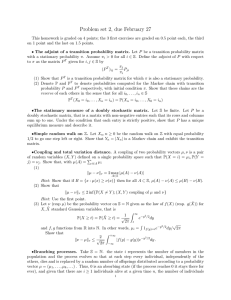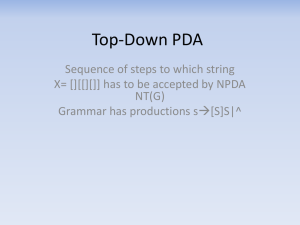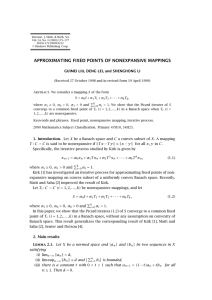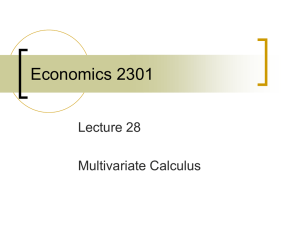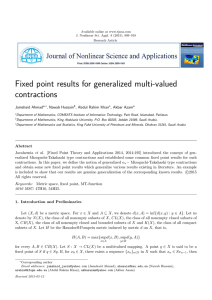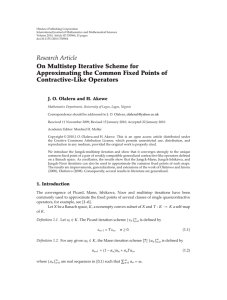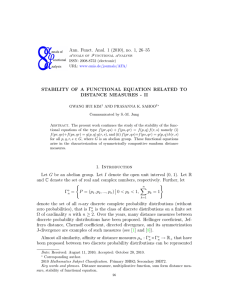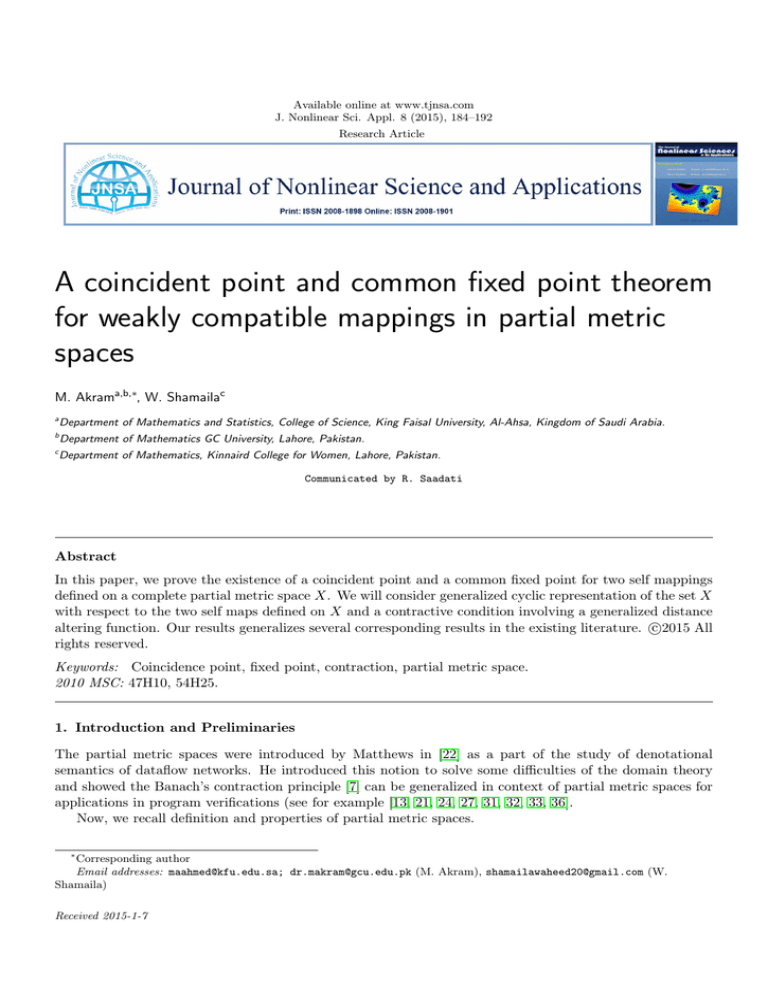
Available online at www.tjnsa.com
J. Nonlinear Sci. Appl. 8 (2015), 184–192
Research Article
A coincident point and common fixed point theorem
for weakly compatible mappings in partial metric
spaces
M. Akrama,b,∗, W. Shamailac
a
Department of Mathematics and Statistics, College of Science, King Faisal University, Al-Ahsa, Kingdom of Saudi Arabia.
b
Department of Mathematics GC University, Lahore, Pakistan.
c
Department of Mathematics, Kinnaird College for Women, Lahore, Pakistan.
Communicated by R. Saadati
Abstract
In this paper, we prove the existence of a coincident point and a common fixed point for two self mappings
defined on a complete partial metric space X. We will consider generalized cyclic representation of the set X
with respect to the two self maps defined on X and a contractive condition involving a generalized distance
c
altering function. Our results generalizes several corresponding results in the existing literature. 2015
All
rights reserved.
Keywords: Coincidence point, fixed point, contraction, partial metric space.
2010 MSC: 47H10, 54H25.
1. Introduction and Preliminaries
The partial metric spaces were introduced by Matthews in [22] as a part of the study of denotational
semantics of dataflow networks. He introduced this notion to solve some difficulties of the domain theory
and showed the Banach’s contraction principle [7] can be generalized in context of partial metric spaces for
applications in program verifications (see for example [13, 21, 24, 27, 31, 32, 33, 36].
Now, we recall definition and properties of partial metric spaces.
∗
Corresponding author
Email addresses: maahmed@kfu.edu.sa; dr.makram@gcu.edu.pk (M. Akram), shamailawaheed20@gmail.com (W.
Shamaila)
Received 2015-1-7
M. Akram, W. Shamaila, J. Nonlinear Sci. Appl. 8 (2015), 184–192
185
Definition 1.1. ([22, 23]) A partial metric ”p” on X is a function from X × X to R+ such that for every
element x, y and z of X it satisfies following axioms.
p1 : 0 ≤ p (x, x) ≤ p (x, y) .
p2 : p (x, x) = p (x, y) = p(y, y) if and only if x = y.
p3 : p (x, y) = p (y, x) . (symmetry)
p4 : p(x, z) ≤ p (x, y) + p (y, z) − p (y, y) . (triangular inequality)
If ”p” is a partial metric on X then (X, p) is called a partial metric space.
Remark 1.2. It is clear that if p (x, y) = 0, then from p1 and p2 x = y. But if x = y then p (x, y) may not be
zero.
Each partial metric ”p” on X generates a T0 topology τp on X which has the collection of all open balls
{Bp (x, ε) : x ∈ X, ε > 0} as a base. Where Bp (x, ε) = {y ∈ X : p (x, y) < p (x, x) + ε} for each ε > 0 and
x ∈ X. Notice that for a partial metric p on X, the function dp : X × X → R+ defined by dp (x, y) =
2p (x, y) − p (x, x) − p (y, y) for all x, y, z ∈ X is a metric on X.
Definition 1.3. ([4, 22, 23])
1. A sequence {xn } in a partial metric space (X, p) converges to the limit x ∈ X if and only if
lim p (x, xn ) = p (x, x).
n→∞
2. A sequence {xn } in a partial metric space (X, p) is called Cauchy if and only if
lim
m,n→∞
p (xm , xn ) exists
and is finite.
3. A partial metric space (X, p) is said to be complete if every Cauchy sequence {xn } in X converges,
with respect to τp , to a point x ∈ X such that lim p (xm , xn ) = p (x, x) .
m,n→∞
4. The mapping f : X → X is said to be continuous at x0 ∈ X If for every ε > 0, there exists δ > 0 such
that f (Bp (x0 , δ)) ⊂ Bp (f (x0 ) , ε) .
The following lemmas will be frequently used in the proofs of the main results.
Lemma 1.4. ([4, 22, 23, 30])
1. A sequence {xn } is a Cauchy sequence in a partial metric space (X, p) if and only if it is a Cauchy
sequence in the metric space (X, dp ).
2. A partial metric space (X, p) is complete if and only if the metric space (X, dp ) is complete. Moreover,
lim dp (x, xn ) = 0, if and only if
n→∞
p (x, x) = lim p (x, xn ) =
n→∞
lim p (xn , xm ) .
n,m→∞
Where x is the limit of {xn } in (X, dp ) .
3. Let (X, p) be a complete partial metric space. Then
(a) If p (x, y) = 0, then x = y.
(b) If x 6= y, then p (x, y) > 0.
4. Let (X, p) be a partial metric space. Assume that the sequence {xn } is converging to z as n → ∞.
such that p (z, z) = 0. Then
lim p (xn , y) = p (z, y) for all elements y of X.
n→∞
Khan et al. [19] initiated the use of control function in the fixed point theory of metric spaces, which they
called an altering distance function. Generalizations of distance altering function have been used in fixed
point theory in metric and probabilistic metric spaces in works like [11, 12, 25, 26, 35]. In [12] Chaudhury
and Dutta presented the following definition of the generalized distance altering function of two variables.
M. Akram, W. Shamaila, J. Nonlinear Sci. Appl. 8 (2015), 184–192
186
Definition 1.5. ([12]) A function ψ : [0, ∞)2 → [0, ∞) is said to be generalized altering distance function
of two variables if :
1. ψ is continuous,
2. ψ is monotone increasing in both variables, and
3. ψ (x, y) = 0 only if x = y = 0.
The class of all such functions are denoted by Ω . We define α (x) = ψ (x, x) for x ∈ [0, ∞) . Clearly α (x) = 0
if and only if x = 0.
In 2003, Kirk et al. [20] introduced the notion of cyclic representation of a non empty set X and
characterized the Banach’s contraction principle in the context of cyclic mapping. After the distinguished
result of Kirk et al. [20], a number of fixed point theorems have been proved, for details see [9, 16, 17, 28,
29, 34]. In 2005, Rus [34] introduced the following definition as the generalization of cyclic mapping defined
in [20].
Definition 1.6. ([34])
S
Let X be a non-empty set, m be a positive integer and F : X → X be a mapping. X = m
i=1 Ai is said to
be the cyclic representation of X with respect to F if
1. Ai , i = 1, 2, ..., m are nonempty sets.
2. F (A1 ) ⊂ A2 , F (A2 ) ⊂ A3 , ..., F (Am−1 ) ⊂ Am , F (Am ) ⊂ A1 .
After this many authors focused on the fixed point theorems for metric spaces as well as on complete
partial metric spaces with generalized cyclic representation, for details see [2, 3, 5, 6, 8, 10, 15, 18]. In [18] the
following notion of generalized cyclic representation of non empty set with respect to two self maps is defined.
Definition 1.7. ([18])
S
Let X be a non-empty set, m be a positive integer and S, T : X → X be two mappings. X = m
i=1 Ai is
said to be cyclic representation of X with respect to S and T if
1. Ai , i = 1, 2, ..., m are nonempty sets,
2. T (A1 ) ⊂ S (A2 ) , T (A2 ) ⊂ S (A3 ) , ..., T (Am−1 ) ⊂ S (Am ) , T (Am ) ⊂ S (A1 ) .
Definition 1.8. ([14])
Let T and S be two self-maps on X. If Sw = T w = z, for some w ∈ X, then w is called a coincidence point
of S and T, and z is called a point of coincidence of S and T . If w = z, then z is called the common fixed
point of S and T.
Definition 1.9. ([14])
Consider the two self-maps S and T defined on a non-empty set X. If ST x = T Sx, for all x ∈ X, then S
and T are said to be commuting maps. If they commute at their coincidence points only then they are said
to be weakly compatible that is, if ST x = T Sx whenever, T x = Sx.
Lemma 1.10. ([1])
Let S and T be weakly compatible self-maps on X. If w is the unique point of coincidence of S and T and
Sw = T w = z, then z will be unique common fixed point of S and T.
2. Main Result
Now, we state the main result of this paper which includes the generalizations given in Definitions 1.5 and
1.7. Lastly we discuss an example to illustrate the usability of the main result.
M. Akram, W. Shamaila, J. Nonlinear Sci. Appl. 8 (2015), 184–192
187
Theorem 2.1. Let (X, p) be a complete
partial metric space, m be a positive integer, A1 , A2 , ...,SAm be
Sm
non-empty subsets of X and X = i=1 Ai . Let S, T : X → X be two self-mappings such that X = m
i=1 Ai
is the cyclic representation of X with respect to S and T, for any x ∈ Ai , y ∈ Ai+1 and i ∈ {1, 2, ..., m} ,
α (p (T x, T y)) ≤ ψ (p (Sx, Sy) , p (Sx, T x)) − φ (p (Sx, Sy) , p (Sx, T x))
(2.1)
is satisfied, where Am+1 = A1 , ψ, φ ∈ Ω and α (x) = ψ (x, x) forTx ∈ [0, ∞) . Suppose that S (Ai ) , for all i
are closed subsets of X. If S is one to one then there exists z ∈ m
i=1 Ai such that Sz = T z. In particular if
the pair {S, T } is weakly compatible then they have a unique common fixed point.
Proof. Let x1 ∈ A1 be an arbitrary element then by the cyclic representation of X we can find an element
x2 ∈ A2 such that T x1 = Sx2 . For x2 ∈ A2 , we can find x3 ∈ A3 such that T x2 = Sx3 . Continuing in this
way, we can construct a sequence {xn } as follows T xn = Sxn+1 , for all n ∈ N. If for some k ∈ N, we have
Sxk+1 = Sxk , then Sxk+1 = Sxk = T xk , which shows that xk is the point of coincidence of S and T. Now,
suppose that Sxn+1 6= Sxn for all n ∈ N. Then by definition of X there exists in ∈ {1, 2, ..., m} such that
xn ∈ Ain+1 and xn−1 ∈ Ain . For x = xn and y = xn−1 we have
α (p (T xn , T xn−1 )) ≤ ψ (p (Sxn , Sxn−1 ) , p (Sxn , T xn ))
−φ (p (Sxn , Sxn−1 ) , p (Sxn , T xn ))
α (p (Sxn+1 , Sxn )) ≤ ψ (p (Sxn , Sxn−1 ) , p (Sxn , Sxn+1 ))
−φ (p (Sxn , Sxn−1 ) , p (Sxn , Sxn+1 ))
≤ ψ (p (Sxn , Sxn−1 ) , p (Sxn , Sxn+1 )) .
(2.2)
Since α (x) = ψ (x, x) , so
ψ (p (Sxn+1 , Sxn ) , p (Sxn+1 , Sxn )) ≤ ψ (p (Sxn , Sxn−1 ) , p (Sxn+1 , Sxn )) .
If p (Sxn , Sxn−1 ) < p (Sxn+1 , Sxn ) , then
α (p (Sxn+1 , Sxn )) ≤ ψ (p (Sxn , Sxn−1 ) , p (Sxn+1 , Sxn ))
< ψ (p (Sxn+1 , Sxn ) , p (Sxn+1 , Sxn )) = α (p (Sxn+1 , Sxn )) ,
which is a contradiction, since ψ is monotone increasing in both variables and α (p (Sxn+1 , Sxn )) 6= 0
whenever p (Sxn+1 , Sxn ) 6= 0. Thus
p (Sxn+1 , Sxn ) ≤ p (Sxn , Sxn−1 )
for all n ∈ N and {p (Sxn+1 , Sxn )} is a decreasing sequence of non-negative real numbers, so there must
exists some r ≥ 0, such that
p (Sxn+1 , Sxn ) → r as n → ∞
(2.3)
Taking limit as n → ∞ in (2.2) then utilizing (2.3) and the definition of ψ and φ we have α (r) ≤ ψ (r, r) −
φ (r, r) < ψ (r, r) = α (r) . Therefore, α (r) = 0. Which forces r = 0. Hence
lim p (Sxn , Sxn+1 ) = 0.
n→∞
(2.4)
As p (Sxn , Sxn ) ≤ p (Sxn+1 , Sxn ) and p (Sxn+1 , Sxn+1 ) ≤ p (Sxn+1 , Sxn ) which implies
lim p (Sxn , Sxn ) = lim p (Sxn+1 , Sxn+1 ) = lim p (Sxn+1 , Sxn ) = 0.
n→∞
n→∞
n→∞
(2.5)
Also by using the definition of dp we have dp (Sxn+1 , Sxn ) = 2p (Sxn+1 , Sxn )−p (Sxn+1 , Sxn+1 )−p (Sxn , Sxn ) ,
and
lim dp (Sxn+1 , Sxn ) = 0.
(2.6)
n→∞
M. Akram, W. Shamaila, J. Nonlinear Sci. Appl. 8 (2015), 184–192
188
To show that {Sxn } is a Cauchy sequence in (X, dp ) . Assume that
n } is not
{Sx
Cauchy
sequence then
there exists some ε > 0 for which we can find the subsequences Sxm(k) and Sxn(k) of {Sxn } with
n(k) > m(k) > k such that
dp Sxm(k) , Sxn(k) ≥ ε.
(2.7)
Further, we can choose n (k) corresponding to m (k) , in such a way that it is the smallest integer satisfying
inequality (2.7), hence
dp Sxm(k) , Sxn(k)−1 < ε.
(2.8)
From inequality (2.7) ,
ε ≤ dp Sxm(k) , Sxn(k) ≤ dp Sxm(k) , Sxn(k)−1 + dp Sxn(k)−1 , Sxn(k)
< ε + dp Sxn(k)−1 , Sxn(k)
Hence,
ε ≤ dp Sxm(k) , Sxn(k) < ε + dp Sxn(k)−1 , Sxn(k) .
(2.9)
We know that,
dp Sxn(k)−1 , Sxn(k) = 2p Sxn(k)−1 , Sxn(k) − p Sxn(k) , Sxn(k)
−p Sxn(k)−1 , Sxn(k)−1 .
Let k → ∞, using (2.4) and (2.5) we get
lim dp Sxn(k)−1 , Sxn(k) = 0.
(2.10)
lim dp Sxm(k) , Sxn(k) = ε.
(2.11)
k→∞
Using (2.10) in (2.9) we have
k→∞
As
dp Sxm(k) , Sxn(k) = 2p Sxm(k) , Sxn(k) − p Sxm(k) , Sxm(k)
−p Sxn(k) , Sxn(k)
Let k → ∞, using (2.5) and (2.11) we get
lim dp Sxm(k) , Sxn(k) = 2 lim p Sxm(k) , Sxn(k) .
k→∞
Therefore
k→∞
ε
lim p Sxm(k) , Sxn(k) = .
k→∞
2
From the triangular inequality
dp Sxn(k) , Sxm(k) ≤ dp Sxn(k) , Sxn(k)+1 + dp Sxn(k)+1 , Sxm(k)+1
+dp Sxm(k)+1 , Sxm(k)
and
dp Sxn(k)+1 , Sxm(k)+1 ≤ dp Sxn(k)+1 , Sxn(k) + dp Sxn(k) , Sxm(k)
+ dp Sxm(k) , Sxm(k)+1
Let k → ∞, and using (2.10) and (2.11) we get
lim dp Sxn(k) , Sxm(k) ≤ lim dp Sxn(k)+1 , Sxm(k)+1
k→∞
k→∞
and
lim dp Sxn(k)+1 , Sxm(k)+1 ≤ lim dp Sxn(k) , Sxm(k)
k→∞
k→∞
(2.12)
M. Akram, W. Shamaila, J. Nonlinear Sci. Appl. 8 (2015), 184–192
189
Hence,
lim dp Sxn(k)+1 , Sxm(k)+1 = lim dp Sxn(k) , Sxm(k) = ε.
k→∞
k→∞
(2.13)
By definition of dp ,
dp Sxm(k)+1 , Sxn(k)+1 = 2 p Sxm(k)+1 , Sxn(k)+1 − p Sxm(k)+1 , Sxm(k)+1
−p Sxn(k)+1 , Sxn(k)+1
Let k → ∞, and using (2.5) we get
lim dp Sxm(k)+1 , Sxn(k)+1 = 2 lim p Sxm(k)+1 , Sxn(k)+1 = ε.
k→∞
k→∞
Hence, we obtain
ε
lim p Sxm(k)+1 , Sxn(k)+1 = .
k→∞
2
(2.14)
By substituting x = xm(k) and y = yn(k) in (2.1) we get
α p T xm(k) , T xn(k)
≤ ψ p Sxm(k) , Sxn(k) , p Sxm(k) , T xm(k)
−φ p Sxm(k) , Sxn(k) , p Sxm(k) , T xm(k)
α p Sxm(k)+1 , Sxn(k)+1
≤ ψ p Sxm(k) , Sxn(k) , p Sxm(k) , Sxm(k)+1
−φ p Sxm(k) , Sxn(k) , p Sxm(k) , Sxm(k)+1
Taking limit as k → ∞, using
(2.4),
(2.14)
obtain
ε (2.12),
ε and the
εcontinuity
εof εφand ψ we
ε
ε
≤ψ
,0 − φ ,0 < ψ
,0 < ψ
,
=α
,
α
2
2
2
2
2 2
2
since ψ is monotone increasing in both variables and φ 2ε , 0 > 0, so the above inequality gives a contradiction
that is ε = 0. Hence {Sxn } is a Cauchy sequence in (X, dp ) . As (X, p) is complete so is (X, dp ) and there
exists some z ∈ X such that
lim dp (Sxn , z) = 0.
(2.15)
n→∞
Also by using Lemma 1.4(2), we have
p (z, z) = lim p (Sxn , z) = lim p (Sxn , Sxm )
n→∞
n→∞
1
=
lim dp (Sxn , Sxm ) = 0.
2 m,n→∞
(2.16)
Which shows that Sxn → z as n →
Tm∞ in the partial metric space (X, p) . Since all S (Ai ) ’s are closed in X,
so z ∈ S(Ai ) for all i. Thus z ∈ i=1 S (Ai ) and there exists zi ∈ Ai such that Szi = z. Also S is given as
0
a one-one mapping
Tmso we have Sz1 = Sz2 = ... =0 Szm = z, which implies z1 = z2 = ... = zm = z , therefore
0
0
Sz = z for z ∈ i=1 Ai and lim Sxn = z = Sz . By construction, the sequence {Sxn } has infinite number
n→∞
of
termsin each Ai . Now fix i ∈ {1, 2, ..., m} such that z ∈ Ai and T z ∈ Ai+1 . We may take a subsequence
Sxn(k) of {Sxn } with Sxn(k) ∈ SAi−1 where xn(k) ∈ Ai−1 and also converges to z. Using (2.16) we have
p (z, z) = lim p (Sxn , z) = lim p Sxn(k) , z = 0.
(2.17)
n→∞
n→∞
put y = xn(k) and x = z 0 in (2.1) we have
α p T z 0 , T xn(k) = α p T z 0 , Sxn(k)+1
≤ ψ p Sz 0 , Sxn(k) , p Sz 0 , T z 0 − φ p Sz 0 , Sxn(k) , p Sz 0 , T z 0
M. Akram, W. Shamaila, J. Nonlinear Sci. Appl. 8 (2015), 184–192
190
Apply limit as n → ∞, using (2.4) and the property of φ and ψ we have
ψ p T z 0 , Sz 0 , p T z 0 , Sz 0 = α p T z 0 , Sz 0
≤ ψ p Sz 0 , Sz 0 , p Sz 0 , T z 0 − φ p Sz 0 , Sz 0 , p Sz 0 , T z 0
≤ ψ p Sz 0 , Sz 0 , p Sz 0 , T z 0 .
p (T z 0 , Sz 0 )
p (Sz 0 , Sz 0 ) ,
Since ψ is monotone increasing so we get
≤
0
0
0
0
p (Sz , Sz ) ≤ p (T z , Sz ) , hence
p Sz 0 , Sz 0 = T z 0 , Sz 0 .
(2.18)
and by definition of small self-distance
If p (Sz 0 , Sz 0 ) 6= 0, then p (Sz 0 , Sz 0 ) > 0 and, from(2.18) we get
ψ p Sz 0 , Sz 0 , p Sz 0 , Sz 0 = α p Sz 0 , Sz 0 ≤ ψ p Sz 0 , Sz 0 , p Sz 0 , Sz 0
−φ p Sz 0 , Sz 0 , p Sz 0 , T z 0
≤ ψ p Sz 0 , Sz 0 , p Sz 0 , Sz 0 .
(2.19)
A contradiction, since ψ ∈ Ω. Thus p (Sz 0 , Sz 0 ) = p (T z 0 , Sz 0 ) = p (T z 0 , T z 0 ) = 0 and T z 0 = Sz 0 = z. Since S
and T are weakly compatible so T T z 0 = T Sz 0 = ST z 0 = SSz 0 , that T
is T z = Sz. Now, we prove that T z = z.
0
0
Since T z 0 ∈ X hence T z 0 ∈ Ai for some i ∈ {1, 2, ..., m} . By z 0 ∈ m
i=1 Ai , we have z ∈ Ai−1 . Put x = z
0
and y = T z in (2.1),
α (p (T z 0 , T T z 0 )) ≤ ψ (p (Sz 0 , ST z 0 ) , p (Sz 0 , T z 0 ))
−φ (p (Sz 0 , ST z 0 ) , p (Sz 0 , T z 0 ))
≤ ψ (p (Sz 0 , ST z 0 ) , p (Sz 0 , T z 0 )) .
Since Sz 0 = T z 0 so from the last inequality we have
α (p (T z 0 , T T z 0 )) ≤ ψ (p (T z 0 , T T z 0 ) , p (T z 0 , T z 0 ))
−φ (p (T z 0 , T T z 0 ) , p (T z 0 , T z 0 ))
≤ ψ (p (T z 0 , T T z 0 ) , p (T z 0 , T z 0 ))
≤ ψ (p (T z 0 , T T z 0 ) , p (T z 0 , T T z 0 )) .
Since ψ ∈ Ω and p (T z 0 , T z 0 ) ≤ p (T z 0 , T T z 0 ) . Thus we have p (T z 0 , T T z 0 ) = 0 and, consequently T z =
T z 0 = T T z 0 = T z = Sz. Let z ∗ ∈ X be another common fixed point of S and T such that z 6= Tz ∗ then
p (z, z ∗ ) 6= 0. Since both z and z ∗ are common fixed point of S and T so by given conditions z, z 0 ∈ m
i=1 Ai .
Using (2.1) we have
α (p (z, z ∗ )) = α (p (T z, T z ∗ )) ≤ ψ (p (Sz, Sz ∗ ) , p (Sz, T z))
−φ (p (Sz, Sz ∗ ) , p (Sz, T z))
< ψ (p (Sz, Sz ∗ ) , p (Sz, T z)) = ψ (p (z, z ∗ ) , p (z, z)) .
Since ψ ∈ Ω and p (z, z) ≤ p (z, z ∗ ) . Which forces p (z, z ∗ ) = 0, that is z = z ∗ .
Corollary 2.2. Let (X, p) be a complete
Sm partial metric space, m be a positive integer, A1 , A2 , ..., Am be
non-empty closed subsets of X, X = i=1 Ai be the cyclic representation of X with respect to the self map
T defined on X. Suppose that there exists functions ψ, φ ∈ Ω, such that
α (p (T x, T y)) ≤ ψ (p (x, y) , p (x, T x)) − φ (p (x, y) , p (x, T x))
is satisfied for any x ∈ Ai , y ∈ Ai+1 i ∈
{1, 2, ..., m} , where Am+1 = A1 , and for x ∈ [0, ∞) , α (x) = ψ (x, x) .
Tm
Then T has a unique fixed point z ∈ i=1 Ai .
Proof. Take Sx = x in Theorem 2.1.
M. Akram, W. Shamaila, J. Nonlinear Sci. Appl. 8 (2015), 184–192
191
Example 2.3. Let X = [0, 1] and define the function p : X × X → R+ by p (x, y) = max {x, y} . Then
2
(X, p) is a complete partial metric space. Let S , T : X → X are such that T x = x16 and Sx = x4 for all
x ∈ X. Suppose that φ, ψ : [0, ∞)2 → [0, ∞) are defined by ψ (x, y) = x + y and φ (x, y) = max {x, y} for
all x, y ∈ [0,
. Let Ai = [0, 1] for i = 1, 2, ..., m. All the conditions of Theorem 2.1 are satisfied and we
T∞)
m
obtain 0 ∈ i=1 Ai as the common fixed point of S and T.
3. Conclusion
A common fixed point theorem for a complete partial metric space has been proved by utilizing the idea
of generalized cyclic representation of a non-empty set and the generalized distance altering function of two
variables. An illustrative example is also given.
References
[1] M. Abbas, G. Jungck, Common fixed point results for noncommuting mappings without continuity in cone metric
spaces, J. Math. Anal. Appl., 341 (2008), 416–420. 1.10
[2] T. Abdeljawad, J. O. Alzabut, A. Mukheimer, Y. Zaidan, Banach contraction principle for cyclical mappings on
partial metric spaces, Fixed Point Theory Appl., 2012, (2012), 7 pages. 1
[3] R. P. Agarwal, M. A. Alghamdi, N. Shahzad, Fixed point theory for cyclic generalized contractions in partial
metric spaces, Fixed Point Theory Appl., 2012, (2012), 11 pages. 1
[4] I. Altun, A. Erduran, Fixed point theorems for monotone mappings on partial metric spaces, Fixed Point Theory
Appl., 2011 (2011), 10 pages. 1.3, 1.4
[5] H. Aydi, E. Karapinar, A fixed point result for Boyd-Wong cyclic contractions in partial metric spaces, Fixed
Point Theory Appl., 2012 (2012), 11 pages. 1
[6] H. Aydi, C. Vetro, W. Sintunavarat, P. Kumam, Coincidence and fixed points for contractions and cyclical
contractions in partial metric spaces, Fixed Point Theory Appl., 2012 (2012), 18 pages. 1
[7] S. Banach, Sur certains ensembles de fonctions conduisant aux quations partielles du second ordre (French) Math.
Z., 27 (1928), 68–75. 1
[8] C. Di Bari, C. Vetro, Common fixed point theorems for weakly compatible maps satisfying a general contractive
condition, Int. J. Math. Math. Sci., 2008 (2008), 8 pages. 1
[9] S. Chandok, M. Postolache, Fixed point theorem for weakly Chatterjea-type cyclic contractions, Fixed Point
Theory Appl., 2013 (2013), 9 pages. 1
[10] C. M. Chen Fixed point theory of cyclical generalized contractive conditions in partial metric spaces, Fixed Point
Theory Appl., 2013 (2013) 15 pages. 1
[11] B. S. Choudhury, A common unique fixed point result in metric spaces involving generalised altering distances,
Math. Commun., 10 (2005), 105–110. 1
[12] B. S. Choudhury, P. N. Dutta, A unified fixed point result in metric spaces involving a two variable function,
Filomat, 14 (2000), 43–48. 1, 1.5
[13] R. Heckmann, Approximation of metric spaces by partial metric spaces. Applications of ordered sets in computer
science (Braunschweig, 1996), Appl. Categ. Structures, 7 (1999), 71–83. 1
[14] G. Jungck, Compatible mappings and common fixed points, Internat. J. Math. Math. Sci., 9 (1986), 771–779. 1.8,
1.9
[15] E. Karapinar, I. M. Erhan, A. Y. Ulus, Fixed point theorem for cyclic maps on partial metric spaces, Appl. Math.
Inf. Sci., 6 (2012), 239–244. 1
[16] E. Karapinar, H. K. Nashine, Fixed point theorems for Kannan type cyclic weakly contractions, J. Nonlinear Anal.
Optim., 4 (2013), 29–35. 1
[17] E. Karapinar, K. Sadarangani, Fixed point theory for cyclic (φ − ψ)-contractions, Fixed Point Theory Appl.,
2011 (2011), 8 pages. 1
[18] E. Karapinar, N. Shobkolaei, S. Sedghi, S. M. Vaezpour, A common fixed point theorem for cyclic operators on
partial metric spaces, Filomat, 26 (2012), 407–414. 1, 1.7
[19] M. S. Khan, M. Swaleh,S. Sessa, Fixed point theorems by altering distances between the points, Bull. Austral.
Math. Soc., 30 (1984), 1–9. 1
[20] W. A. Kirk, P. S. Srinivasan, P Veeramani, Fixed points for mappings satisfying cyclical contractive conditions,
Fixed Point Theory, 4 (2003), 79–89. 1
[21] H.-P. A. Knzi, H. Pajoohesh, M. P. Schellekens, Partial quasi-metrics, Theoret. Comput. Sci., 365 (2006), 237–
246. 1
[22] S.G. Matthews, Partial metric topology. Research Report 212. Dept. of Computer Science. University of Warwick,
(1992). 1, 1.1, 1.3, 1.4
M. Akram, W. Shamaila, J. Nonlinear Sci. Appl. 8 (2015), 184–192
192
[23] S. G. Matthews, Partial metric topology, Papers on general topology and applications (Flushing, NY, 1992),
183–197, Ann. New York Acad. Sci., 728, New York Acad. Sci., New York, (1994). 1.1, 1.3, 1.4
[24] M. Bukatin, R. Kopperman, S. Matthews, H. Pajoohesh, Partial metric spaces, Amer. Math. Monthly, 116
(2009), 708–718. 1
[25] D. Mihet, Altering distances in probabilistic Menger spaces, Nonlinear Anal., 71 (2009), 2734–2738. 1
[26] S. V. R. Naidu, Some fixed point theorems in metric spaces by altering distances, Czechoslovak Math. J., 53
(2003), 205–212. 1
[27] S. J. O’Neill, Partial metrics, valuations, and domain theory, Papers on general topology and applications
(Gorham, ME, 1995), 304–315, Ann. New York Acad. Sci., 806, New York Acad. Sci., New York, (1996). 1
[28] M. Pacurar, I. A. Rus, Fixed point theory for cyclic φ-contractions, Nonlinear Anal., 72 (2010), 1181–1187. 1
[29] M. A. Petric, Some results concerning cyclical contractive mappings, Gen. Math., 18 (2010), 213–226. 1
[30] S. Romaguera, A Kirk type characterization of completeness for partial metric spaces, Fixed Point Theory Appl.,
2010 (2010), 6 pages. 1.4
[31] S. Romaguera, M. Schellekens, Duality and quasi-normability for complexity spaces, Appl. Gen. Topol., 3 (2002),
91–112. 1
[32] S. Romaguera, M. Schellekens, Partial metric monoids and semivaluation spaces, Topology Appl., 153 (2005),
948–962. 1
[33] S. Romaguera, O Valero, A quantitative computational model for complete partial metric spaces via formal balls,
Math. Structures Comput. Sci., 19 (2009), 541–563. 1
[34] I. A. Rus, Cyclic representations and fixed point, Ann T.Popviciu seminar funct. Eq. Approx. convexity., 3 (2005),
171–178. 1, 1.6
[35] K. P. R. Sastry, G. V. R. Babu, Some fixed point theorems by altering distances between the points, Indian J.
Pure Appl. Math., 30 (1999), 641–647. 1
[36] M. P. Schellekens, A characterization of partial metrizability: domains are quantifiable, Topology in computer
science (Schloß Dagstuhl, 2000). Theoret. Comput. Sci., 305 (2003), 409–432. 1

